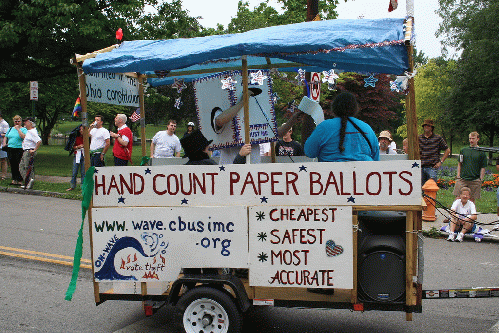From Truthout
By Bob Fitrakis and Harvey Wasserman
If Donald Trump ever does leave the White House, we can in large part thank paper ballots.
Hand-marked and hand-counted paper ballots have long been at the core of the U.S.'s rising election protection movement. They were largely scorned after the disastrous 2000 campaign, when badly designed "butterfly ballots" and "hanging chads" undermined Florida's election, giving George W. Bush an Electoral College victory despite losing the nationwide popular vote.
In response, Congress voted for the $2 billion Help America Vote Act (HAVA). Deeming them a clean, efficient way to vote, HAVA spread computerized touch screen machines throughout the country. However, the push to spread the machines was tainted after their main backer, Ohio Congressman Bob Ney, went to prison on unrelated corruption charges.
High-profile hackers' mockery of the machines has also helped to damage their credibility. For example, one professor hacked a "secure" touchscreen and got it to play the University of Michigan fight song.
According to the highly respected Verified Voting website, in 2006 less than half the nation's votes (47.7 percent) were cast in jurisdictions using mostly hand-marked paper ballots. In 2020 it was 70 percent. Another 18.1 percent were cast on ballot-marking devices used to mark paper ballots. Thus, this year, nearly 9 out of every 10 votes cast in the U.S. were marked on paper. Virtually all were counted with digital scanners, leaving the preserved original ballots intact for Trump's bitterly contested recounts.
By contrast, the use of direct recording electronic (DRE) "black box" touchscreen machines dropped from 43.9 percent in 2006 to just 11.9 percent in 2020. Some of those DRE machines allow the voter to view a poorly printed, usually fragile paper record to confirm how one voted, but others do not. In either case, the paper has been unusable for recounts, which have relied entirely on the electronic equipment itself, making them virtually meaningless.
Over the years, frequent breakdowns and critical shortages of those DRE machines have led to long Election Day lines. Lights on the touchscreens have often gone haywire, falsely indicating voters had chosen one candidate when in fact they'd chosen another. Critics have branded the process "push and pray." Since they fail to create a usable paper trail, these machines turn recounts into a bitter charade. And when the official results tabulated by the machines have not jibed with exit polls (as has happened often), those unhappy with the results have had an easier time deeming the election "stolen."
Another major risk involved with computerized touch screen machines is that nearly all are privately owned by companies like Diebold, Dominion and ES&S, which have been unwilling to make public their source codes. The courts have ruled in their favor, calling the codes that have decided our elections "proprietary." With their operational cores hidden, there's thus been no reliable way to confirm the outcome of an election conducted on electronic touchscreens.
Had the 2020 election been predominantly run on those machines, there'd be no reliable way to deter Trump's incredible claims of widespread fraud. He has predictably attacked results from Dominion ballot marking devices in Georgia. But his attacks couldn't change the Georgia result because the preserved paper ballots were available for essentially unassailable recounts.
Had touchscreen machines with black box counting devices been as prevalent nationwide as they were in 2006, the 2020 outcome would be impossible to sort out, and Trump could skate through the confusion.
(Note: You can view every article as one long page if you sign up as an Advocate Member, or higher).






